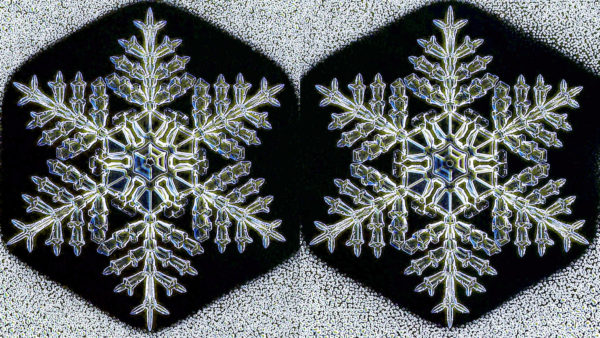"Lives are snowflakes - unique in detail, forming patterns we have seen before, but as like one another as peas in a pod (and have you ever looked at peas in a pod? I mean, really looked at them? There's not a chance you'd mistake one for another, after a minute's close inspection.)" -Neil Gaiman
When you see a snowflake, what you're seeing is a thin crystal of ice, with intricate, hexagonally-symmetric features that reveal themselves under a microscope. Although snowflakes come in a myriad of different shapes and patterns, there's one adage you've heard since you were a kid: that no two snowflakes are alike.
 Two nearly identical snow crystals as grown under laboratory conditions at Caltech. Image credit: Kenneth Libbrecht / Caltech / SnowMaster 9000.
Two nearly identical snow crystals as grown under laboratory conditions at Caltech. Image credit: Kenneth Libbrecht / Caltech / SnowMaster 9000.
From a scientific perspective, is that true? What gives snowflakes their intricate structures, and what does it truly mean for a snowflake to be unique? Do we require the exact same branching structure? Can we obtain that if we create them artificially? Do we require identical-ness down to a molecular or atomic level? And how much snow would we need for that to happen?
 The formation and growth of a snowflake, a particular configuration of ice crystal. Image credit: Vyacheslav Ivanov, from his video at Vimeo: http://vimeo.com/87342468.
The formation and growth of a snowflake, a particular configuration of ice crystal. Image credit: Vyacheslav Ivanov, from his video at Vimeo: http://vimeo.com/87342468.
Come find out the real science behind two snowflakes being alike on this week's Ask Ethan!
- Log in to post comments
More like this
“You can’t cross the sea merely by standing and staring at the water.” –Rabindranath Tagore
You can’t answer a hypothetical question for certain, at least in science, without doing the experiment for yourself. Here on Earth, liquid water is plentiful; our planet has the stable temperatures and…
"They say that every snowflake is different. If that were true, how could the world go on? How could we ever get up off our knees? How could we ever recover from the wonder of it?" -Jeanette Winterson
Here in Portland, it's just cold for now. But much of the world has been blanketed in those…
“I hope that in this year to come, you make mistakes. Because if you are making mistakes, then you are making new things, trying new things, learning, living, pushing yourself, changing yourself, changing your world. You're doing things you've never done before, and more importantly, you're doing…
It didn't make the news, because skittish media types are mostly based in New York City and thus don't care about anything north of Westchester County, but we had a big snow storm yesterday. It started snowing Sunday night, though, and kept up through pretty much dinnertime Monday. Both the local…





I dunno. i see a lot of snowflakes that look alike lol..:
https://www.youtube.com/watch?v=d_KMyppREKQ
Every time you go to a trump rally.
Lol!